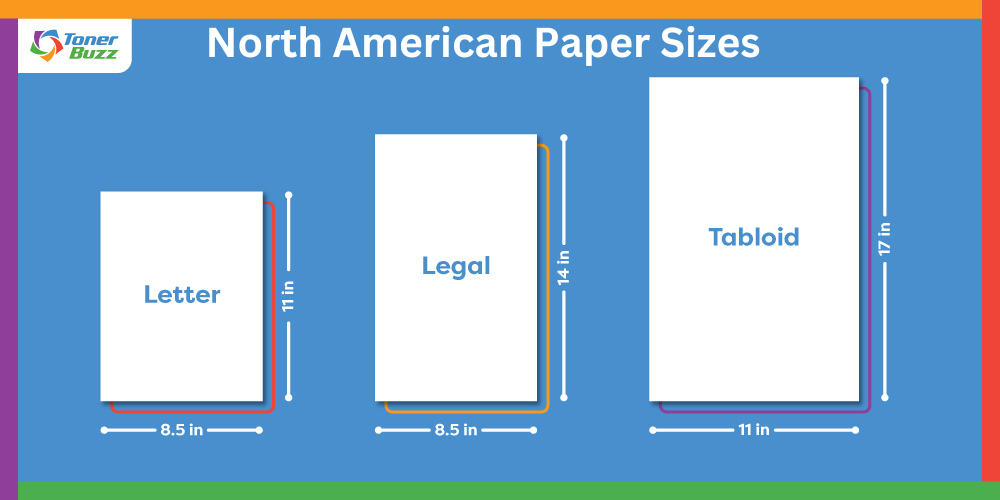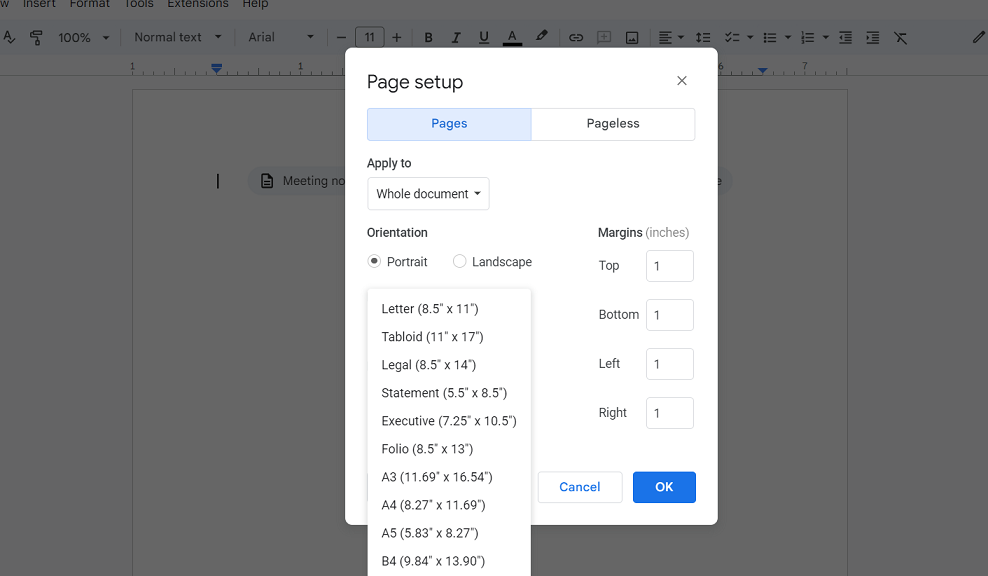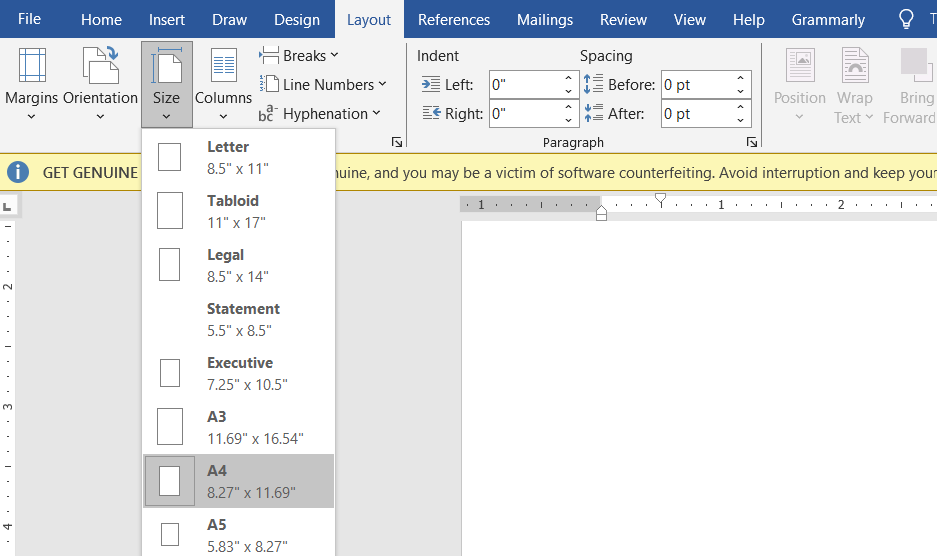Printer Paper Sizes: The Ultimate Guide by Toner Buzz
03/11/2024

✅ Quick Overview:
The widely used global A4 size measures 210 x 297 mm or 8.27 x 11.69 inches. It's smaller than A3 (297 x 420 mm or 11.69 x 16.54 inches) but larger than A5 (148 x 210 mm or 5.83 x 8.27 inches).
In North America, the most common paper size is Letter, which measures 8.5 by 11 inches (216 by 279 mm). This is smaller than Legal size paper, which is 8.5 by 14 inches (216 by 356 mm). There's also a larger size called Tabloid, measuring 11 by 17 inches (279 by 432 mm).
Global Paper Sizes (ISO 216 Standard)
The ISO 216 standard, incorporating the widely used A4 size, serves as the global standard for paper size.
The ISO 216 standard includes the A, B, and C series of paper sizes. The B series is larger than A and commonly used for posters, while the C series is primarily for envelopes. Other series like D, E, F, and RA serve specialized purposes such as architectural drawings and educational posters.
Among these, the A series is the most widely recognized for general printing purposes. The sizes in the A series are defined by halving the size of the preceding paper in the series along its larger dimension, maintaining a constant aspect ratio of 1:√2.
Here are some of the most commonly used A series sizes:
| Format | Inches | Millimeters | Used for |
| A3 | 11.69x16.54 | 297x420 | Larger documents, charts, small posters |
| A4 | 8.27x11.69 | 210x297 | Documents, letters, forms |
| A5 | 5.83x8.27 | 148x210 | Notepads, flyers, small booklets |
A 4 Paper
A4 paper, measuring 210 x 297 mm (8.27 x 11.69 inches), is perhaps the most widely recognized paper size worldwide. It's highly versatile and commonly used for different documents such as letters, forms, reports, and more.
Whether you're printing out a resume, filling out a standardized form, or creating a professional report, A4 provides a standard format that is easily recognized and compatible with most printing and copying equipment.
Interestingly, the global market for A4 laser printers is expanding, moving from $14,440 million in 2022 to an anticipated $19,995.78 million by 2031. This trend underscores the central role of A4 paper size in the future of document printing and management.

A 3 Paper
A3 ( 297 x 420 mm or 11.69 x 16.54 inches) serves as a larger alternative within the A series, making it suitable for documents requiring more space such as diagrams, charts, and small posters.
For instance, if you're creating a detailed floor plan or a presentation board for a project, A3 provides the room you need.
A 5 Paper
A5 paper, on the other hand, is smaller at 148 x 210 mm (5.83 x 8.27 inches). Its smaller dimensions make it convenient for jotting down notes or creating concise promotional materials, while still retaining the consistent aspect ratio of the A series for easy scaling and printing.
Here's the image showcasing the visual and dimensional differences between A3, A4, and A5 paper sizes.

North American Paper Sizes
| Format | Size in inches | Size in millimeters | Used for |
| Letter | 8.5 x 11 | 216 x 279 | Everyday printing and document creation |
| Legal | 8.5 x 14 | 216 x 356 | Legal documents |
| Tabloid | 11 x 17 | 279 x 432 | Larger documents |
In the United States and Canada, the most common paper sizes are based on traditional formats. The most frequently used sizes include:
Letter
This standard-sized paper, measuring 8.5 inches by 11 inches (216 x 279 mm), is the preferred choice for everyday printing and document creation.
It closely resembles the international A4 size but is slightly wider and shorter. Commonly used for documents such as letters, reports, resumes, and flyers.
Legal
Legal-sized paper, measuring 8.5 inches by 14 inches (216 x 356 mm), is commonly used for documents that require more space for text or additional content.
It offers extra length compared to the standard letter size, making it suitable for printing longer agreements or forms that require more room for signatures or detailed terms and conditions.
Tabloid
Tabloid-sized paper, measuring 11 inches by 17 inches (279 x 432 mm), is larger than standard letter and legal sizes. Also known as Ledger or B-size, it is commonly used for printing larger documents such as newspapers, newsletters, posters, menus, and large diagrams.
The tabloid size provides ample space for displaying content in a more prominent format, making it ideal for projects that require a larger canvas or visual impact.
Here's the image showcasing the visual and dimensional differences between North American paper sizes.

<
Other Common Formats
- Photo Sizes: Common sizes include 4x6 inches, 5x7 inches, and 8x10 inches, tailored for photo printing.
- Business Card Size: Typically 3.5 x 2 inches in the U.S. and Canada, but can vary globally.
- Envelope Sizes: Vary widely, with common sizes like #10 for business letters, designed to fit a standard Letter-sized document folded into thirds.
Check also: Facts About Paper
History of Paper Sizes
First, the idea of using a ratio of √2 for paper sizes was proposed by German scientist Georg Christoph Lichtenberg in 1786. This concept gained further attention when mathematician Lazare Carnot proposed standardized paper formats in France in 1798.
Building on these ideas, Walter Porstmann developed a comprehensive paper size system based on the √2 ratio in the early 20th century. This system was later adopted as the DIN standard in Germany in 1922.
By 1975, the widespread adoption of this system led to its establishment as an ISO standard, with A4 becoming the global standard size. By 1977, A4 had become the standard letter format in 88 out of 148 countries, reflecting the widespread adoption and acceptance of the standardized paper size system.
The origins of US letter-size paper (8.5 x 11 inches) are not entirely clear, but it's thought to be linked to traditional papermaking, where the length was about a quarter of a papermaker's arm stretch.
As the industry evolved, the US adopted this size to accommodate both machine-made and handmade papers. There was a time when the government used a slightly different size (8" x 10.5"), while the private sector used the now-familiar 8.5" x 11".
This discrepancy was resolved in the 1980s when the Reagan administration officially standardized the 8.5" x 11" size. Building on this standardization, in 1995, the American National Standards Institute (ANSI) further formalized this size by adopting ANSI/ASME Y14.1, which defined paper sizes based on the 'US Letter' size, designating it as 'ANSI A'.
Letter Size vs. A4
Letter size is slightly wider and shorter, while A4 is a bit taller and narrower, so there are a few considerations to keep in mind to avoid any issues.
Impact on Documents: These differences might seem minor, but they can affect document formatting. For instance, a document designed for Letter size might not print correctly on A4 paper, cutting off content or leaving unwanted margins.
Choosing Wisely: It's essential to select the appropriate paper size based on the document's intended audience and region. This ensures that your document is presented as intended, without any formatting issues.
Printer Preferences: Depending on where you are, printers are often set up for the region's standard paper size. In the United States or Canada, printers are typically optimized for Letter size. However, in places like Europe, Asia, and Australia, where A4 is the standard, printers are more likely to be configured for A4 paper by default. This is an important factor to consider when purchasing a printer or preparing documents for printing in different regions.
Software Settings: Pay attention to the default paper size settings in your document creation software, especially when sharing documents internationally. Adjust printer settings to match the paper size. If you're printing A4 stuff on Letter paper, shrink it to 94% so it fits. And if you're sending Letter size to places that use A4, you might need to make it 97% of the original size because A4 is a bit narrower.
Cultural and Regional Norms: Understanding the preferred paper size in your target region can facilitate smoother communication and document exchange. Adapting to these norms shows attentiveness and respect for your audience's standards.
Adjusting Paper Size in Documents
Whether you're preparing a report, creating a flyer, or designing a presentation, knowing how to adjust paper size can be useful.
Here's how you can do it in Google Docs and Microsoft Word:
For Google Docs
- Open your document in Google Docs.
- Click on File in the menu bar.
- Select Page setup from the dropdown menu.
- In the Page setup dialog box, you can change the paper size under the Paper size dropdown menu.
- Choose the desired paper size from the list or select Custom to input custom dimensions.

Page Setup in Google Docs
For Microsoft Word
- Open your document in Microsoft Word.
- Click on the Layout or Page Layout tab in the ribbon menu, depending on your Word version.
- Look for the Size option, usually located in the Page Setup group.
- Click on the dropdown menu next to Size to select the desired paper size.
- You can also click on More Paper Sizes at the bottom of the dropdown menu to input custom dimensions or choose from additional preset sizes.

Paper Size in MS Word
Note: In Microsoft Office applications like Excel and PowerPoint, you can adjust the paper size settings similarly to Word.
Look for options related to Page Layout, Page Setup, or Design depending on the application you are using. From there, you can select the desired paper size from the available options or input custom dimensions if needed.
Summary
In summary, understanding the differences between global and North American paper sizes requires grasping their distinctions.
While the ISO 216 standard governs international sizes, North America adheres to its own standards like Letter, Legal, and Tabloid sizes.
Adapting to these differences promotes smooth communication and proper document formatting across regions.
 Calculating arrival date
Calculating arrival date








